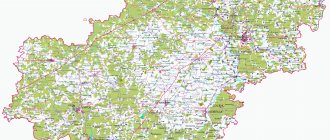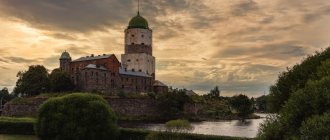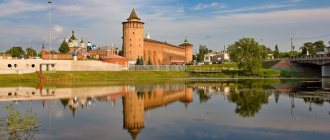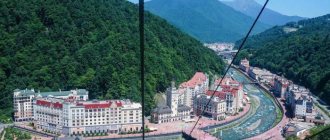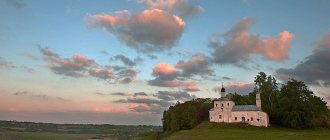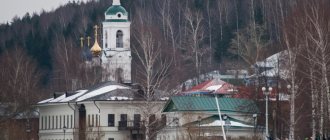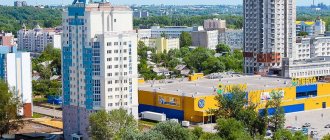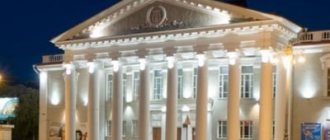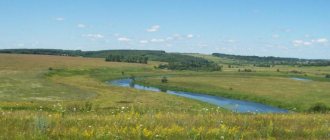The largest region in the Central part of Russia is the Nizhny Novgorod region. Its area is about 80 km2. The satellite map of the Nizhny Novgorod region shows that it is elongated in the meridional direction from north to south.
The region's borders include the following areas:
- Kostroma;
- Kirovskaya;
- Vladimirskaya;
- Ryazan;
- Ivanovskaya.
The eastern borders are limited by Chuvashia and the Mari El Republic.
A map of the Nizhny Novgorod region by district gives an idea of all the objects. For example, you can consider the hydrography of the region, which is represented by the country’s largest rivers, the Volga and Oka. In total, more than 9,000 rivers and streams flow through the region, including the following:
- Sura;
- Uzola;
- Drunk;
- Kudma;
- Linda;
- Tesha;
- Vetluga.
If you use a map of the Nizhny Novgorod region with diagrams and move along it to the western borders of the region, you can find the place where Lake Pyrskoe is located - the largest in the region. And if you zoom in on the map, the streets and houses of cities, administrative facilities, as well as roads and railways will become accessible.
Districts of the Nizhny Novgorod region on the map
The region is divided into 42 districts. Nizhny Novgorod is located in the center of the region. All areas on the map of the Nizhny Novgorod region can be viewed in detail using online maps.
The Nizhny Novgorod region is an industrial region, so its districts and urban districts contain a large number of industrial enterprises. The following areas have the highest socio-economic indicators:
- Arzamas;
- Kstovsky;
- Diveevsky;
- Vyksunsky;
- Borsky;
- Gorodetsky.
High industrial potential is also noted in Dzerzhinsk. Streets, houses, administrative facilities and highways of any city can be viewed on a map of the Nizhny Novgorod region with settlements.
Large agricultural areas are:
- Volodarsky;
- Perevozsky;
- Bolsheboldinsky;
- Sharangsky.
Due to the fact that all the settlements in the region have a long history, each district has its own historical, natural, architectural monuments, which can be found on the map of the Nizhny Novgorod region with villages:
- Gorodets district is a center of architecture and folk art;
- Lyskovsky district - a museum network has been preserved that characterizes the original culture of the Slavs;
- Boldinsky district is the family nest of the family of the great poet A.S. Pushkin;
- Diveyevo district is a place of mass pilgrimage;
- The Kerzhensky district is a protected area and a place where several natural reserves are located.
The districts of the Nizhny Novgorod region are connected by a developed transport network. On a detailed road map of the Nizhny Novgorod region you can see that the M-7 highway passes through the region and its center, which connects Tatarstan with Moscow.
Geographical location of the Nizhny Novgorod region, relief, rivers, lakes
The region's territory is located along the banks of the Volga in the center of the East European Plain.
It is cut by many rivers. There are more than 9,000 of them in the region. The most significant of them are the Volga and Oka. The left bank areas of the region are characterized by swampy lowlands. There are many ravines and lakes in the region. The largest lake in the region is Pyrskoe. Forests occupy 46% of the region's territory. The online map of the Nizhny Novgorod region shows the borders with neighboring regions. These include the Kirov, Ryazan, Vladimir and Ivanovo regions. In the east, the Nizhny Novgorod region borders with Mari El and Chuvashia, in the south - with Mordovia.
Climate
The region is located in the temperate continental climate zone. On average, the region receives 600-650 mm of precipitation per year in the Left Bank part of the region and 500-550 mm in the Right Bank. The first snow in the region falls in November and does not disappear until March. In winter, the thermometer can drop to -25-28°C, and in summer it can rise above +28-30°C.
Population
The majority of the region's population is Russian. Their share in the total composition is 94.9%. They are followed by the Tatars - 1.44% and Mordovians - 0.7%. Most of the region's residents are city dwellers.
Economy
The Nizhny Novgorod region belongs to the industrially developed regions of the country. Its most famous enterprises are:
- in mechanical engineering - OJSC GAZ (Nizhny Novgorod);
- in metallurgy - Vyksinsky Metallurgical Plant;
- in aircraft manufacturing - Aircraft Building (Nizhny Novgorod);
- in the chemical industry - JSC "Orgsintez" Dzerzhinsk.
A large number of military-industrial complex enterprises are located in the region. The city of Sarov is considered the center of nuclear development. The food industry is well developed in the region.
Map of the Nizhny Novgorod region with cities and villages
In addition to the main metropolis, the ten largest cities in the region, which can be seen on a map of the Nizhny Novgorod region with cities and villages, include:
- Dzerzhinsk;
- Arzamas;
- Sarov;
- Vyksna;
- Kstovo.
The architecture of city streets in large cities is unique. In the neighborhood you can see workshops of industrial enterprises, mansions of the late 19th century, Khrushchev buildings and modern buildings made of glass and concrete. If we look at the map of the Nizhny Novgorod region in detail, we can note that the main cities of the region are important railway junctions, through which not only the Gorky Railway line passes, but also narrow-gauge tracks intended for the needs of industry and the extraction of natural resources.
Rural infrastructure is often entirely dedicated to tourism development. Almost every locality has ancient temples, architectural and historical monuments. There are entire fishing communities that create souvenirs.
Size and geographical location.
The Nizhny Novgorod region is one of the forty-nine regions of the RSFSR, spread across the vast expanses of our Motherland. It covers an area of about 75 thousand square kilometers. This is, for example, more than one and a half times the area of the Moscow region.
From end to end, from southwest to northeast, our region stretches for half a thousand kilometers. Its lands, sometimes forest, sometimes almost steppe, freely spread along both banks of the great Russian river Volga, going far to the north and south - to where the Vetluga flows from the north, and from the south - the main right tributary of the Volga Oka and Sura, where steppes and forest-steppes end and forests begin, first deciduous, and then mixed and coniferous. The territory of the region, thus, being at the junction of different natural zones, generally has transitional features of nature, distinguished by significant landscape diversity. The diversity of the nature of the Nizhny Novgorod region is also due to the fact that one part of it is located on the low left bank of the Volga, and the other on the high right bank, on the Volga Upland, which represents a sharp contrast in comparison with the low-lying Trans-Volga region, as the left bank of the region is commonly called. The Volga in the region is the main natural boundary: in relief and climate, and for rivers, and for soil and vegetation cover. In the European part of the RSFSR, on the Russian Plain, the Nizhny Novgorod region occupies an almost central position, being approximately equal distance, more than a thousand kilometers, from the western, northern and southern seas. The region's territory is most influenced by the western seas - the Atlantic Basin, which softens the continental climate of the country's interior.
The convenient location of the Nizhny Novgorod region in the center of the European part of the country, as well as the most important waterways - the Volga and Oka - passing through its territory, make this position very advantageous. By waterways, natural and artificial (canals), the Nizhny Novgorod region is connected with all the seas washing the European part of the country. The geographical position of the region has long been favorable to its development. The only disadvantage of the geographical location of the Nizhny Novgorod region is its comparative distance from the main bases of the most important minerals: coal, oil, chemical raw materials, iron ores. The Nizhny Novgorod region, formed in 1929 from the Nizhny Novgorod province, was determined in its modern borders mainly in 1944, when northern Povetluzhie became part of the Kostroma region.
It is surrounded by five regions and three autonomous republics, the border with which runs mostly through forests, and in the southern half also along rivers (Oka and Sura). Consequently, the borders of the Nizhny Novgorod region, which were formed mainly historically, have natural boundaries in a number of places. From the north, where the border reaches 58°06′ northern latitude (near the city of Vetluga), and the northeast, the Nizhny Novgorod region borders on the Kirov region, from the north-west - on Kostroma, from the west - on Ivanovo and Vladimir regions, from the east - with the Mari and Chuvash Republics, from the southeast and south, where the border touches 54°27′ northern latitude, - with the Mordovian Republic and from the southwest - with the Ryazan region.
Together with the Kirov region and three autonomous republics, the Nizhny Novgorod region is part of the Volga-Vyatka economic region, in which our region forms the industrial core, being the most industrially developed. The Nizhny Novgorod region is one of the most important industrial bastions of the country with highly developed mechanical engineering and chemistry, as well as forestry, pulp and paper, woodworking and other industries. As you can see, the geographical location of the Nizhny Novgorod region consists of various aspects that are important for both its physical-geographical and economic-geographical characteristics.
Economy and industry of the Nizhny Novgorod region
The region has traditionally developed heavy industry and mechanical engineering. Yandex maps of the Nizhny Novgorod region can become an indispensable assistant in finding the right enterprise. The region's engineering industry operates in both the civil and defense sectors. Its products account for more than 40% of all manufactured goods. Enterprises produce:
- cars;
- trucks;
- buses;
- special equipment.
Giant enterprises specialize in shipbuilding, aircraft products, and the design of instruments and machines for nuclear energy.
The Nizhny Novgorod region is a large agricultural region of the country. Farms are engaged in meat and dairy farming. Grain, sugar beets, potatoes, and onions are grown in regional fields. Off-season cultivation of vegetables has been developed using greenhouses and small farm enterprises.
Coronavirus statistics in the Nizhny Novgorod region December 9, 2021
As of December 9, 2021, another 627 cases of coronavirus infection have been identified in the Nizhny Novgorod region. The total number of residents of the Nizhny Novgorod region with a confirmed diagnosis of coronavirus is 220,383.
190,824 residents of the Nizhny Novgorod region have recovered, that is, 86.59% of the total number of patients who were diagnosed with coronavirus are already healthy. Over the past 24 hours, 747 people who had previously been diagnosed with coronavirus were discharged.
34 people died during the day, for the entire time 9,193 people died.
As of December 9, 2021, 1,626,217 people were vaccinated with the first component of the vaccine, and 1,457,121 people completed vaccination.
No coronavirus cases were found in 13 Nizhny Novgorod municipalities
Outside of Nizhny Novgorod, the largest increase was detected in the Balakhninsky district.
No new cases of coronavirus have been detected in 13 districts and urban districts of the Nizhny Novgorod region. This was reported by the press service of the governor and the regional government.
Let us remind you that as of December 8, the number of infected people in the Nizhny Novgorod region reached 219,756 cases since the beginning of the pandemic. 135,620 of them are in districts and urban districts (+473 over the past day) and 84,136 (+191) in Nizhny Novgorod. No new cases of coronavirus were found in 13 districts of the Nizhny Novgorod region over the past weekend.
Outside the regional center, the largest increase was detected in the Balakhninsky district. In this territory, 74 new people infected with coronavirus were immediately added, and their total number was 7,322 people.
In which cities and districts of the Nizhny Novgorod region coronavirus was detected as of December 9, 2021
List of districts and urban districts of the Nizhny Novgorod region where cases of coronavirus infection have been confirmed (as of December 9):
Ardatovsky - 1,069 Arzamas - 3,521 (+10) Arzamassky - 1,959 (+46) Balakhninsky - 7,350 (+28) Bogorodsky - 4,102 (+2) Bolsheboldinsky - 1,043 (+1) Bolshemurashkinsky - 876 Bor - 10,688 (+3) Buturlinsky - 498 Vadsky - 772 (+1) Varnavinsky district - 653 (+1) Vachsky - 1,907 Vetluzhsky - 1,678 Voznesensky - 762 Volodarsky - 3,632 (+14) Vorotynsky - 935 (+6) Voskresensky - 1,280 (+1) Vyksa - 4,313 (+2) Gaginsky - 1,083 Gorodetsky - 7,503 (+16) Dalnekonstantinovsky - 1,059 Dzerzhinsk - 20,366 (+96) Diveevsky - 1,271 Knyagininsky - 971 (+1) Koverninsky - 1,595 (+2) Krasnobakovsky - 1,394 (+5) Krasnooktyabrsky - 1,093 (+1) Kstovsky - 3,829 (+29) Kulebaksky - 4,135 Lukoyanovsky - 2,043 Lyskovsky - 3,672 Navashinsky — 3,491 Pavlovsky — 5,949 (+5) Pervomaisky — 441 (+8) Perevozsky — 503 (+4) Pilninsky — 1,946 (+1) Pochinkovsky — 1,968 Semenovsky — 1,974 (+2) Sergachsky — 2,027 ( +1) Sechenovsky - 1,338 Sokolsky - 991 (+2) Sosnovsky - 2,323 (+6) Spassky - 469 (+1) Tonkinsky - 915 Tonshaevsky - 1,651 Urensky - 3,006 Chkalovsky - 1,725 (+2) Sharangsky - 963 Shatkovsky - 3,067 (+2) Shakhunsky - 4,077 Sarov - 22,730 (FMBA data) Nizhny Novgorod - 84,464 (+328)
